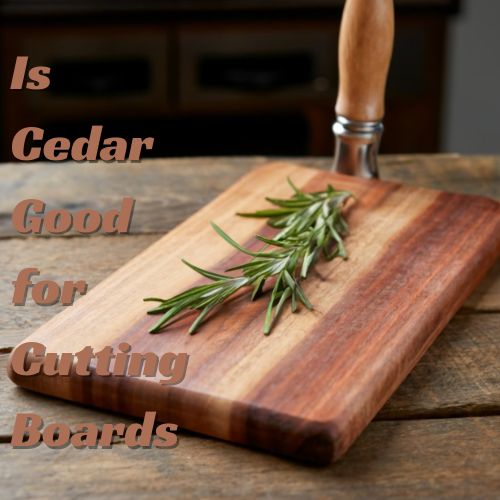The choice of wood for cutting boards is crucial for both culinary enthusiasts and professional chefs. While there are various options available, cedar often piques the interest of those seeking a unique and aromatic solution. In this comprehensive guide, we will explore whether cedar is a suitable choice for cutting boards. We’ll delve into its characteristics, benefits, maintenance, and help you make an informed decision for your kitchen.

Table of Contents
- Introduction: The Quest for the Ideal Cutting Board
- Cedar Wood: Aromatic and Unique
- Cedar Cutting Boards: Characteristics and Benefits
- Long-Tail Queries: Exploring the Versatility of Cedar Cutting Boards
- Maintenance and Care for Cedar Cutting Boards
- FAQs About Cedar Cutting Boards
- Conclusion: Aromatic and Functional
1. Introduction: The Quest for the Ideal Cutting Board
Cutting boards are essential tools in any kitchen, and choosing the right material can greatly impact your culinary experience. In this guide, we’ll focus on cedar wood as a potential choice and assess its suitability for cutting boards.
2. Cedar Wood: Aromatic and Unique
2.1. Characteristics
- Aroma: Cedar wood is known for its pleasant and distinctive aroma, which can add a unique element to your kitchen.
- Color: Cedar varies in color from pale yellow to reddish-brown, offering an attractive and warm appearance.
2.2. Benefits
- Insect-Repellent Properties: Cedar’s natural oils and aroma act as an insect repellent, protecting your cutting board from pests.
- Low Density: Cedar is relatively lightweight, making it easy to handle and move around in the kitchen.
3. Cedar Cutting Boards: Characteristics and Benefits
3.1. Cutting Surface
- Gentle on Knives: Cedar is a softer wood, which can be gentler on knife edges, reducing blade dulling.
- Knife Marks: Cedar cutting boards may show knife marks over time, which some individuals find charming.
3.2. Aroma
- Aromatic Appeal: Cedar’s delightful aroma can enhance the cooking experience and help keep your kitchen smelling fresh.
- Infusion of Flavor: The aroma of cedar may subtly infuse a pleasant flavor into your food.
4. Long-Tail Queries: Exploring the Versatility of Cedar Cutting Boards
4.1. Can cedar cutting boards be used for all types of food?
Cedar cutting boards are best suited for fruits, vegetables, and bread due to their softer surface. However, they may not be ideal for cutting raw meat, as it can leave marks and potentially absorb unwanted odors.
4.2. How can you maintain the aroma of cedar cutting boards?
To maintain the aroma, lightly sand the surface and wash it with a mild detergent. You can also use cedar oil to refresh the scent.
4.3. Do cedar cutting boards require special care?
Cedar cutting boards benefit from regular oiling to preserve their appearance and aroma. They should also be kept dry to prevent warping or cracking.
4.4. Are there any alternatives to cedar cutting boards with similar characteristics?
Maple, cherry, and walnut cutting boards offer similar benefits with variations in hardness and appearance.
4.5. Can you use cedar cutting boards for decorative purposes in the kitchen?
Cedar cutting boards can double as decorative pieces due to their pleasant aroma and warm appearance.
5. Maintenance and Care for Cedar Cutting Boards
Proper maintenance and care are essential to ensure the longevity of cedar cutting boards. Follow these steps to keep your cutting board in top condition:
- Regular Oil Application: Apply food-grade mineral oil or cedar oil to the board’s surface every few weeks.
- Hand Wash Only: Wash your cedar cutting board by hand with mild soap and warm water, and dry it thoroughly after each use.
- Avoid Immersion: Never submerge your cedar cutting board in water, as prolonged exposure to moisture can cause warping and cracking.
- Rejuvenate the Aroma: To refresh the cedar aroma, sand the surface gently and reapply cedar oil as needed.
6. FAQs About Cedar Cutting Boards
6.1. Can cedar cutting boards be used for cutting raw meat?
While cedar cutting boards can be used for raw meat, it’s advisable to reserve them for fruits, vegetables, and bread to prevent meat juices from leaving marks and odors.
6.2. How can you remove stains and odors from a cedar cutting board?
To remove stains and odors, scrub the board with a mixture of baking soda and water or lemon juice. Rinse and dry thoroughly.
6.3. What are the alternatives to cedar cutting boards?
Maple, cherry, and walnut cutting boards are popular alternatives to cedar, each offering distinct characteristics and appearances.
7. Conclusion: Aromatic and Functional
Cedar cutting boards are unique additions to any kitchen, bringing a delightful aroma and natural insect-repellent properties to your culinary space. While they may not be the best choice for cutting raw meat, they are ideal for fruits, vegetables, and bread. With proper care, a cedar cutting board can be both functional and aromatic, enhancing your cooking experience. So, is cedar good for cutting boards? The answer is a resounding yes, with the right expectations and maintenance.
Not Sure What Are You Looking At? Check the below guides:
Pine Tree vs Cedar Tree
Customizing Plywood with Stains and Finishes
